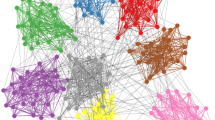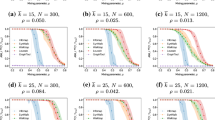Abstract
The aim of this paper is to check feasibility of using the maximal-entropy random walk in algorithms finding communities in complex networks. A number of such algorithms exploit an ordinary or a biased random walk for this purpose. Their key part is a (dis)similarity matrix, according to which nodes are grouped. This study en- compasses the use of a stochastic matrix of a random walk, its mean first-passage time matrix, and a matrix of weighted paths count. We briefly indicate the connection between those quantities and propose substituting the maximal-entropy random walk for the previously chosen models. This unique random walk maximises the entropy of ensembles of paths of given length and endpoints, which results in equiprobability of those paths. We compare the performance of the selected algorithms on LFR benchmark graphs. The results show that the change in performance depends very strongly on the particular algorithm, and can lead to slight improvements as well as to significant deterioration.
Similar content being viewed by others
References
S. Fortunato, Phys. Rep. 486, 75 (2010)
Z. Burda, J. Duda, J.M. Luck, B. Waclaw, Phys. Rev. Lett. 102, 160602 (2009)
Z. Burda, J. Duda, J.M. Luck, B. Waclaw, Acta Phys. Pol. B 41, 949 (2010)
B. Waclaw, Generic Random Walk and Maximal Entropy Random Walk, Wolfram Demonstration Project
J.K. Ochab, Z. Burda, Phys. Rev. E 85, 021145 (2012)
J.K. Ochab, Stationary States of Maximal Entropy Random Walk and Generic Random Walk on Cayley trees, Wolfram Demonstration Project
J.K. Ochab,Dynamics of Maximal Entropy Random Walk and Generic Random Walk on Cayley trees, Wolfram Demonstration Project
J.K. Ochab, Acta Phys. Pol. B 43, 1143 (2012)
J.H. Hetherington, Phys. Rev. A 30, 2713 (1984)
L. Demetrius, V.M. Gundlach, G. Ochs, Theor. Popul. Biol. 65, 211 (2004)
L. Demetrius, T. Manke, Phys. A 346, 682 (2005)
V. Zlatic, A. Gabrielli, G. Caldarelli, Phys. Rev. E 82, 066109 (2010)
J.-C. Delvenne, A.-S. Libert, Phys. Rev. E 83, 046117 (2011)
R. Sinatra, J. Gómez-Gardeñes, R. Lambiotte, V. Nicosia, V. Latora, Phys. Rev. E 83, 030103 (2011)
C. Monthus, T. Garel, J. Phys. A: Math. Theor. 44, 085001 (2011)
K. Anand, G. Bianconi, S. Severini, Phys. Rev. E 83, 036109 (2011)
W. Parry, Trans. Amer. Math. Soc. 112, 55 (1964)
S. White, P. Smyth, KDD ’03: Proceedings of the Ninth ACM SIGKDD International Conference on Knowledge Discovery and Data Mining, Washington, DC, 2003 (ACM, New York, USA, 2003), p. 266
D. Harel, Y. Koren, FST TCS ’01: Proceedings of the 21st Conference on Foundations of Software Technology and Theoretical Computer Science (Springer-Verlag, London, UK, 2001), p. 18
M. Latapy, P. Pons, Lect. Notes Comput. Sci. 3733, 284 (2005)
H. Zhou, Phys. Rev. E 67, 061901 (2003)
H. Zhou, Phys. Rev. E 67, 041908 (2003)
H. Zhou, R. Lipowsky, Lect. Notes Comput. Sci. 3038, 1062 (2004)
J.G. Kemeny, J.L. Snell, Finite Markov Chains (Springer Verlag, New York, 1976)
C.M. Grinstead, J.L. Snell, Introduction to Probability (American Mathematical Society, Providence, RI, 1997)
J.K. Ochab, Phys. Rev. E 86, 066109 (2012)
L. Donetti, M.A. Munoz, J. Stat. Mech., P10012 (2004)
K.A. Eriksen, I. Simonsen, S. Maslov, K. Sneppen, Phys. Rev. Lett. 90, 148701 (2003)
I. Simonsen, Phys. A 357, 317 (2005)
J. Shi, J. Malik, IEEE Trans. Pattern Anal. Mach. Intell. 22, 888 (2000)
M. Meila, J. Shi, AI and STATISTICS (AISTATS) (2001)
A. Capocci, V.D.P. Servedio, G. Caldarelli, F. Colaiori, Phys. A 352, 669 (2005)
E. Estrada, N. Hatano, Phys. Rev. E 77, 036111 (2008)
E. Estrada, N. Hatano, Appl. Math. Comput. 214, 500 (2009)
M.E.J. Newman, M. Girvan, Phys. Rev. E 69, 026113 (2004)
A. Lancichinetti, S. Fortunato, F. Radicchi, Phys. Rev. E 78, 046110 (2008)
A. Lancichinetti, S. Fortunato, Phys. Rev. E 80, 056117 (2009)
L. Danon, A. Díaz-Guilera, J. Duch, A. Arenas, J. Stat. Mech.: Theory Exp., P09008 (2005)
Author information
Authors and Affiliations
Corresponding authors
Rights and permissions
About this article
Cite this article
Ochab, J., Burda, Z. Maximal entropy random walk in community detection. Eur. Phys. J. Spec. Top. 216, 73–81 (2013). https://doi.org/10.1140/epjst/e2013-01730-6
Received:
Revised:
Published:
Issue Date:
DOI: https://doi.org/10.1140/epjst/e2013-01730-6




